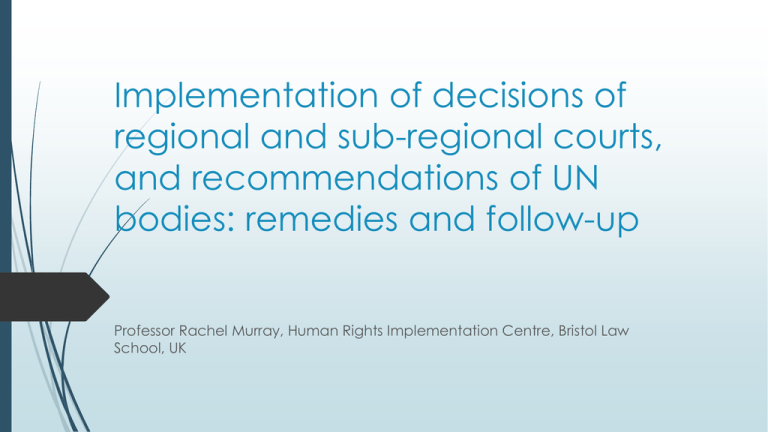Implementation of decisions of regional and sub-regional courts, and recommendations of UN
advertisement

Implementation of decisions of regional and sub-regional courts, and recommendations of UN bodies: remedies and follow-up Professor Rachel Murray, Human Rights Implementation Centre, Bristol Law School, UK Responsibility of the State to implement Combination of factors explains compliance and implementation: nuanced and coordinated approach among range of actors at national, regional and international levels National level: Range of actors: government units; judiciary, parliament, NHRIs, CSOs, etc. Limited awareness of existence of African Commission/Court and its findings Legislation enforcing decision of treaty bodies, but in very few states Role of UNCTs Whose responsibility? Whose responsibility is it to monitor implementation and compliance? Credibility and legitimacy of the TB depends on extent to which decisions implemented Should the TB be monitoring implementation and compliance? Should it differ depending on whether the TB is a Court or quasi-judicial body? African Court: Article 29 of the Protocol provides that the (now Executive Council) shall ‘be notified of the Judgment and shall monitor its execution on behalf of the Assembly’. It is the ministerial level organ of the AU which shall ‘monitor’ implementation and compliance, and the role of the Court is simply to highlight to the AU organs which States have failed to comply. This is done through identifying, in its report each year to the Assembly under Article 31, those States who have not implemented its orders for interim measures and judgments Lessons to be learnt from Inter-American system regarding its role in monitoring compliance? Who should be gathering information? Need for sufficient resources Systematic record of implementation Use of other mechanisms to obtain information: state reporting, visits to states, special rapporteurs, etc. Rigorous analysis and cross checking ‘Implementation dossiers’ Challenges of measuring compliance and implementation Indicators and other tools Variety of different approaches across treaty bodies: ‘full’, ‘partial’, ‘noncompliance’, etc. Using the Court re non-compliance of African Commission decisions Rule 118(1): ‘If the Commission has taken a decision with respect to a communication submitted under Articles 48, 49 or 55 of the Charter and considers that the State has not complied or is unwilling to comply with its recommendations in respect of the communication within the period stated in Rule 112(2), it may submit the communication to the Court pursuant to Article 5 (1) (a) of the Protocol and inform the parties accordingly’. Added value? Role of the Court as ‘enforcer’? The political bodies Need to take an interest ‘Collective nature’ of political supervision Forum for political, rather than legal, debate Assist in identifying what is practically required Draw on examples from other regional bodies of roles of political organs Role of UN organs Preference among variety of actors to look to the UN rather than the AU Greater engagement of UN bodies with the African Court and Commission and its decisions Greater visibility of African bodies’ findings within UN documents Strategic engagement Need for greater coordination and integration Between AU organs and bodies: AU Human Rights Strategy Between AU, African Commission, Court and UN Consistency The treaty body to take the lead on coordination? Facilitate Contextualise Active not activist


